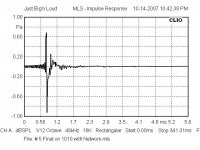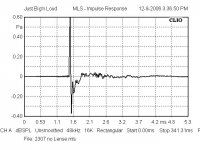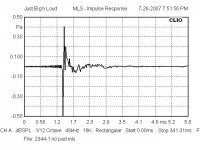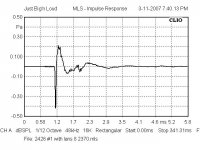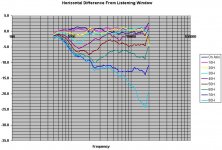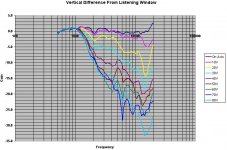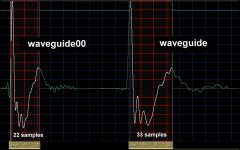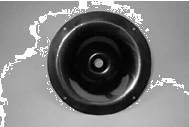Hello Earl
"More the measurements in this thread. They all have different drivers and the drivers have resonances. So it very hard to tell what resonances are from the driver and what are from the horn. Resonances are resonances."
OK fair enough but only the PTH1010 has a different driver. The rest are using a 2426 1" driver. When I was taking them it was not to compare CSD measurements or from all one set-up. Based on that alone there is some variation in them.
"Others can bastardize the term "waveguides", but that doesn't mean that I have to. If it has intentional diffraction as a directivity controlling means then, to me, it is a difraction horn. Smooth it, round it, do whatever you want, it still relies on diffraction for its control, and that, to me, is a no-no."
Fair enough.
"Could you somehow get me those impulses and the names, photos preferably. E-mail or post either way. I'd like to look at them all at one time."
Sure I will set them up in CLIO and post them as JPGs. If you want I can email you text files.
"I might have to do a study sometime of the spectragram to see if the HOM can be seen in it. "
That would be great if we could see them. I was wondering if they could be seen in a CSD plot.
Rob🙂
"More the measurements in this thread. They all have different drivers and the drivers have resonances. So it very hard to tell what resonances are from the driver and what are from the horn. Resonances are resonances."
OK fair enough but only the PTH1010 has a different driver. The rest are using a 2426 1" driver. When I was taking them it was not to compare CSD measurements or from all one set-up. Based on that alone there is some variation in them.
"Others can bastardize the term "waveguides", but that doesn't mean that I have to. If it has intentional diffraction as a directivity controlling means then, to me, it is a difraction horn. Smooth it, round it, do whatever you want, it still relies on diffraction for its control, and that, to me, is a no-no."
Fair enough.
"Could you somehow get me those impulses and the names, photos preferably. E-mail or post either way. I'd like to look at them all at one time."
Sure I will set them up in CLIO and post them as JPGs. If you want I can email you text files.
"I might have to do a study sometime of the spectragram to see if the HOM can be seen in it. "
That would be great if we could see them. I was wondering if they could be seen in a CSD plot.
Rob🙂
soongsc said:
My experience is that sticking anything in the direct path of the wave is a trade-off issue.
Foam will cause lose of detail which may make the sound a bit lifeless in the home environment
I think that foam plug in a CD works very different from placing foam in front of a dome tweeter or ribbon
Maybe it changes the horn flare device into a device that mainly controls directivity ... I am sure he will argue with that
As Earl said, the throath transistion and rounded mouth are the main factors
I would like to see a horn flare that doesnt need that foam plug ... maybe much bigger mouth roundings will do the trick ... outer edges may have to be rounded too ... its seen before
ZilchLab said:
"Diffraction waveguide" is an oxymoron in your view, then?
Mere diffractive intent is sufficient to disqualify a device from being a waveguide?
Did you find a "diffraction device" in the EconoWave "horn?"
The differential flare rates comprising the "dogboneing," perhaps? There's certainly no conventional constriction apparent.
Is this a "Walks like a duck" thing?
Yes, Waveguide theory is different form Horn theory (read my paper). Either its a waveguide or its not. And waveguides MEAN seperable corrdinate geometry that minimizes diffraction. Otherwise you are bastardizing the original meaning of the term. I coined it, I get to say what it means.
You are trying to confuse the issue.
tinitus said:
I would like to see a horn flare that doesnt need that foam plug ... maybe much bigger mouth roundings will do the trick ... outer edges may have to be rounded too ... its seen before
Thats not possible as I have shown. Thus, the foam plug does the best that can be done. You can accept this or not, but it is true.
How about some relevant measurements of the 2370? Attached are the half-space anechoic responses of a DE200 on a 2370A (eqed to get listening window flat) at 10 degree increments horizontally out to 80 degrees. It's not complete crap but it's not very good.
Attachments
Attached are the same except in the vertical plane. This is crap, as expected. If you're spraying sound at people directly in front of you outside it probably works well, but I wouldn't want this in a home stereo... I don't care how nice you can get things on axis.
Attachments
salas said:
Just a 15inch cone with puffy rounded mouth lips and a foam insert is roughly the good stuff? Or there is much more to correctly describe the idea in layman's terms?
Well its maybe a little mre complex that that. (I've nebeem drinlkin Bourbon all night and neeed to go to beeed.)
Robh3606 said:First one PTH1010
Rob🙂
Robh3606 said:Second 2307
Rob🙂
Robh3606 said:Third 2344
Rob🙂
Were all these taken with exactly the same setup? Mic and mic preamp etc?Robh3606 said:Last 2370
Rob🙂
I would imagine very tough decisions are necessary in the design process. I've tried some different designs before, but decided that some analysis would narrow the focus of prototype building.tinitus said:
I think that foam plug in a CD works very different from placing foam in front of a dome tweeter or ribbon
Maybe it changes the horn flare device into a device that mainly controls directivity ... I am sure he will argue with that
As Earl said, the throath transistion and rounded mouth are the main factors
I would like to see a horn flare that doesnt need that foam plug ... maybe much bigger mouth roundings will do the trick ... outer edges may have to be rounded too ... its seen before
Hello,
Earl, due to "friday evening fever" and as I was in a hurry to leave my office, i inverted my "rule of 3".
The sampling frequency of signal "waveguide00" is not (3/2) 48k but (2/3) 48k so it is 32k.
We can verify using the CSD graphs.
On the CSD graph of signal "waveguide00" for t=0 the curve is abruptely cut for the maximum frequency diplayed. Now if we look for the same level on the CSD (t = 0) for the signal "waveguide" we find 16k, this means that the sampling frequency of signal "waveguide00" is 2 times this (Nyquist frequency) so Fs = 32k.
About taking 2 reference points on the 2 signals, this is done with the pulses normalized, merged and correctly trimmed (see attached screen copy).
Best regards from Paris, France
Jean-Michel Le Cléac'h
The level
Earl, due to "friday evening fever" and as I was in a hurry to leave my office, i inverted my "rule of 3".
The sampling frequency of signal "waveguide00" is not (3/2) 48k but (2/3) 48k so it is 32k.
We can verify using the CSD graphs.
On the CSD graph of signal "waveguide00" for t=0 the curve is abruptely cut for the maximum frequency diplayed. Now if we look for the same level on the CSD (t = 0) for the signal "waveguide" we find 16k, this means that the sampling frequency of signal "waveguide00" is 2 times this (Nyquist frequency) so Fs = 32k.
About taking 2 reference points on the 2 signals, this is done with the pulses normalized, merged and correctly trimmed (see attached screen copy).
Best regards from Paris, France
Jean-Michel Le Cléac'h
The level
gedlee said:
Well that doesn't sound right since I have never used 72 kHz. Only 50k, 48k and rarely 44.1k and 32k, but I highly doubt its either of the last two. How do you know the reference points were of the same event. These two files were generated in different facilities with different equipment on different systems (different serial numbers same design) and measured at different distances.
Attachments
gedlee said:
Yes, Waveguide theory is different form Horn theory (read my paper). Either its a waveguide or its not. And waveguides MEAN seperable corrdinate geometry that minimizes diffraction. Otherwise you are bastardizing the original meaning of the term. I coined it, I get to say what it means.
What it means to you, surely, but not as a term of art in general usage.
In Bauman, Adamson & Geddes (1992), you acknowledged:
"It should be noted the term waveguide has been used widely in referring to all types of horns. In this discussion ... waveguide will refer to those specifically derived in terms of the oblate spheroidal coordinate system described by Geddes."
Well, fine, and in respect for you and your important work in this area, I suspect everyone's willing to go along with that here, but also with the understanding that in the industry and the literature at large, the term is not so narrowly construed....
gedlee said:
You are trying to confuse the issue.
No, merely illustrating that with technological advances such as Progressive Transition, it becomes increasingly difficult to sustain the distinction as meaningful in either implementation or performance:
"Looks like OS in the vertical...."
"Head and shoulders better than most diffraction horns...."
Rybaudio said:Attached are the same except in the vertical plane. This is crap, as expected. If you're spraying sound at people directly in front of you outside it probably works well, but I wouldn't want this in a home stereo... I don't care how nice you can get things on axis.
Better EQ'd than not, surely.
It's promoted as not requiring EQ, but I've never been able to get it sounding better than what it is, SR gear. Others seem to be satisfied with that.
What do Altec 811B and 511A look like off axis?
Shootz yeah! I thought waveguides were for RF - like microwaves. Isn't that were the term originated?
Of course, they use the term "horn" in RF too, or at least used to.
Of course, they use the term "horn" in RF too, or at least used to.
panomaniac said:Shootz yeah! I thought waveguides were for RF - like microwaves. Isn't that were the term originated?
Of course, they use the term "horn" in RF too, or at least used to.
...IIRC, "transmission line" is also an RF term that made it's way into "audio".
...bunch of copy cats.
gedlee said:
Well its maybe a little mre complex that that. (I've nebeem drinlkin Bourbon all night and neeed to go to beeed.)
Is this a right example?
Attachments
- Status
- Not open for further replies.
- Home
- Loudspeakers
- Multi-Way
- Horn vs. Waveguide
